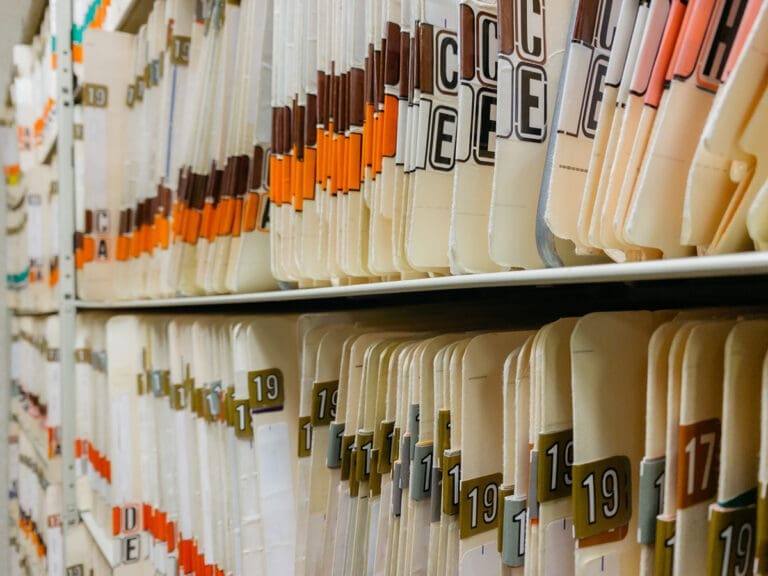There’s so much in life to remember, whether you’re looking at the course of your own life or time spanning across generations. Documents play an important role in preserving memories, whether through official records or any number of other materials.
However, many of these documents won’t stand the test of time. Archival document storage provides a solution to maintain them indefinitely for future generations to appreciate.
Understanding Archival Storage
What is archival storage? It’s a cornerstone of preserving history. In the most basic terms, it’s the practice of storing records in a way that extends their lifespan, preserving them for future reference and study. Without archival document storage, many records would wither away and be rendered virtually useless.
Fluctuations in temperature and humidity are among the most prominent threats to paper and other common materials. These conditions can lead to records breaking down quickly or being damaged over time. Even light exposure and airborne contaminants can take a significant toll over the years. Carefully controlling those conditions is the only way to protect original documents.
Each medium presents unique challenges for long-term preservation. Paper, photographs, film, and even electronic records are all susceptible to various types of decay. Understanding those specific risks and addressing them properly is the key to effective archival storage.
While modern technology has produced great improvements in archival document storage, the practice dates back as long as there have been documents to preserve. History is filled with examples like Egypt’s Library of Alexandria, Alexander the Great’s massive collection that was ultimately lost. While many historical documents have been sadly lost, much of what we know about historical document preservation is owed to those losses.
Today, countless archival facilities around the world house documents of great importance. Some of the largest include the National Archives and Records Administration (NARA) in the United States, which is responsible for safeguarding the Declaration of Independence, and the British Library in the U.K., which holds the Magna Carta.
These are just a few of the few of the important documents stored in global archives around the world. Alongside these history-defining documents, there are also countless other records that help shape our understanding of the past. Continuing to preserve documents today ensures that those in the future will have that same opportunity.
Best Practices for Storing Archival Documents
Archival document storage requires a meticulous approach to ensure proper protection. Understanding the specific risk posed to any given document is key to ensuring adequate storage procedures. Developing this understanding by investigating documents and determining their material is the first step.
From there, the next step is ensuring proper archive temperature and humidity. These factors can quickly impact any type of document, so creating the right storage environment is essential. Other factors, such as light and specific contaminants, must also be considered.
Alongside storage considerations, there must also be careful deliberation regarding document handling. Archival documents must be handled with the proper equipment and procedures to prevent damage, whether physical or from contaminants.
Similar considerations must go into choosing the proper storage method. The construction and materials used in storage containers may impact documents, so they are also carefully controlled.
Bringing all of these important aspects together enables professional archivists to preserve documents over the long term.
Archival Storage Materials
Documents must be stored in some kind of container, whether that’s a sleeve, envelope, box, or other item. Choosing the right archival storage material is a critical decision that will impact the longevity of the stored documents. These types of materials are often referred to as “archival quality,” although it is important to identify specific risks when handling any documents.
Acidity in storage materials is one of the most significant threats in archival paper storage. Acid and lignin in these materials can lead to documents becoming yellow and brittle over the years. Standard paper products often contain these compounds, so special acid-free and lignin-free variants are used.
Most types of documents will be stored in some kind of box, although often within another container inside. Boxes provide an effective defense against light and dust, along with reducing the risk of physical damage. The specific type of box will be selected to ensure protection while still allowing for air circulation.
Folders and sleeves are the go-to solution for most paper documents. Isolating the individual items helps minimize handling. For some items, such as photographs and film, special sleeves that block UV light are used.
Optimal Storage Environment
The storage environment itself is also critical. Improper conditions allow for mold growth, chemical reactions, and other serious threats that lead to decay. A temperature between 60 and 65 degrees Fahrenheit is typically best. It’s also important to minimize fluctuations as much as possible, as these can lead to condensation and moisture collection.
Controlling humidity is also key. High humidity leads to mold growth and other problems, while low humidity dries out fragile documents. A humidity of around 40% is the best for archival document storage and must be carefully controlled to avoid fluctuations.
Archival document storage facilities should have backup power sources to ensure climate control in the event of power failure. For archival document storage, every contingency must be accounted for to ensure that one-time events don’t cause lasting damage to records.
Armstrong Archives Offers Climate-Controlled Archival Document Storage
Choosing the optimal storage environment for your important documents is essential to ensure long-term preservation. Armstrong Archives provides archival document storage tailored to your unique needs. We take the time to understand the specific risks associated with historical document preservation and address them fully.
If you’re not sure about how to store archival documents, the experts at Armstrong Archives can help. We provide comprehensive consultations to uncover the right solution for safely storing any type of materials. You can rest easy knowing that your documents are safe and secure.
We offer a secure, climate-controlled storage option for documents that must be stored at optimal temperature and humidity. We also offer additional services, such as document scanning, to digitize your documents and maintain electronic backups. For a custom quote on your archival document storage needs, contact Armstrong Archives today.












